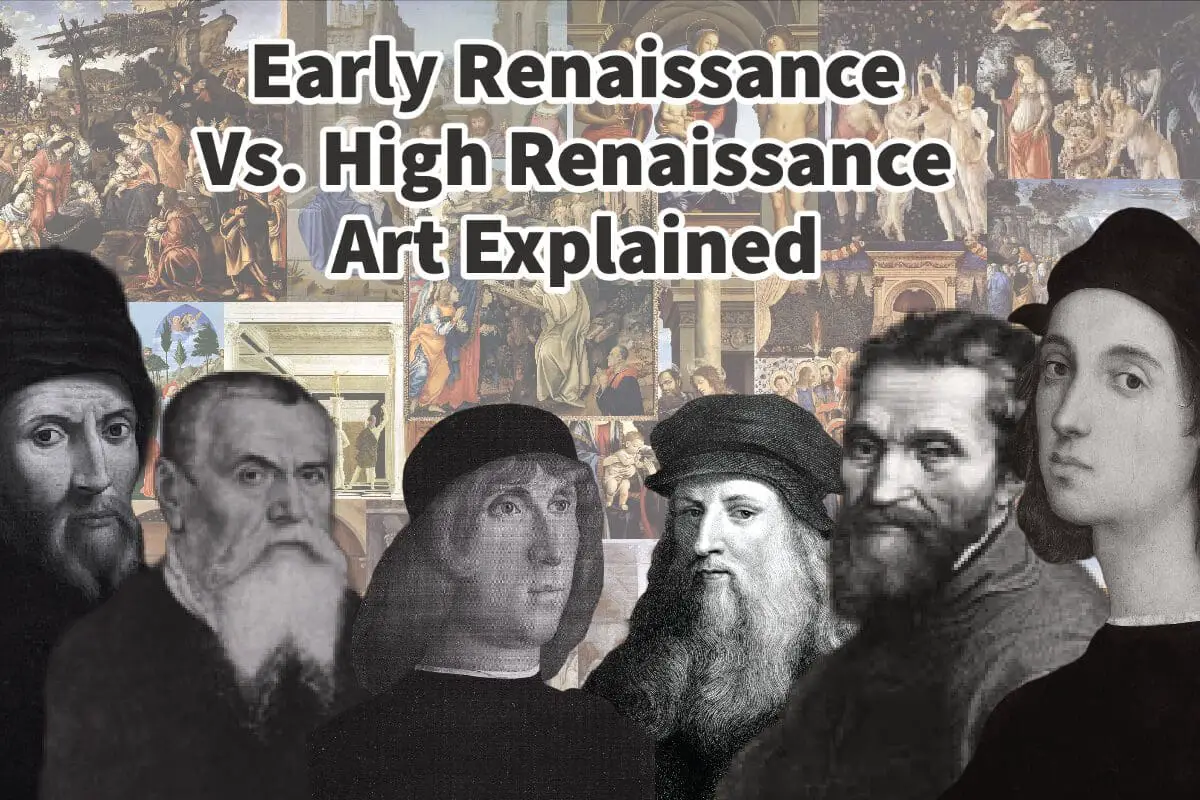The Renaissance period art is considered one of the most essential art periods. Renaissance Art was known to be a time of “rebirth.”
Early Renaissance and High Renaissance are both periods of the art of the Renaissance era. The entire Renaissance era shared a lot of the same characteristics. The High Renaissance was dominated by three major artists: Leonardo da Vinci, Michelangelo, and Raphael.
Table of Contents
- Early Renaissance Vs. High Renaissance Art Period Explained
- The Renaissance “Rebirth” Term Explained
- 12 Reasons Why I’m Enamored with the Renaissance Period of Art
- Frequently Asked Questions
- Related Questions
Early Renaissance Vs. High Renaissance Art Period Explained
Many believe that the Renaissance was just one period of art, but the truth is that the Renaissance can be divided into several different art movements. Two of those most significant movements were the Early Renaissance and High Renaissance Art movements.
Early Renaissance Art Explained
The Early Renaissance art movement started in Florence, Italy, from the 1400s to 1495. It flourished and started in Florence, Italy, considered the cultural capital of Italian Renaissance art.
Here are some of the main characteristics of the Early Renaissance:
- Focus On Realism – The Early Renaissance was when artists started to focus on realism in their art and paintings.
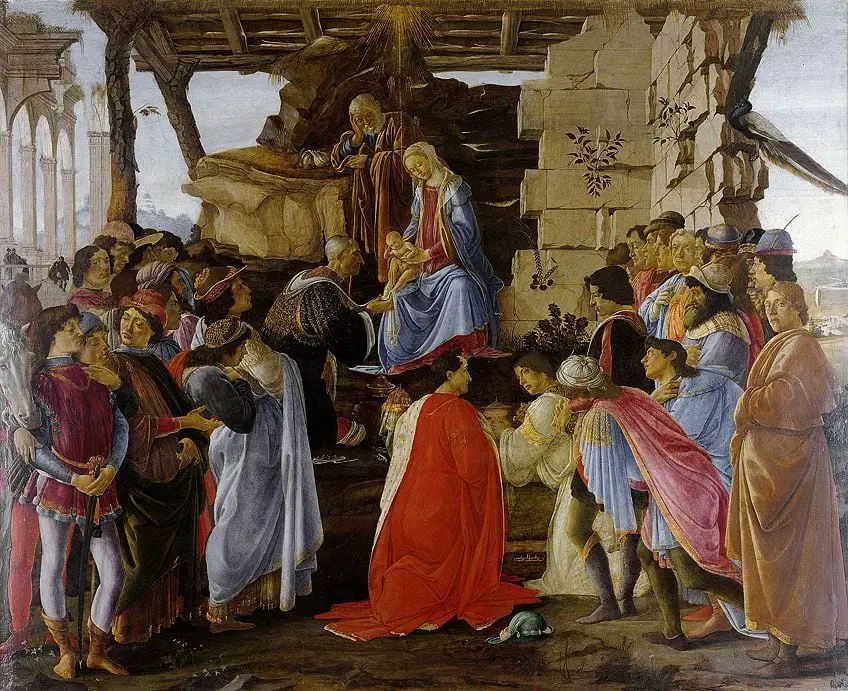
Adoracion of The Magi (1476) By Sandro Botticelli
- Humanism Ideal – During the Renaissance, humanist ideals were a substantial cultural shift in Europe. These humanist ideals included new ideas at the time for self-reliance and civic virtue, along with the belief among ordinary people in uniqueness, dignity, and value for human life.
- Naturalism In Art – Naturalism became very important during the Renaissance, and human figures were depicted with more anatomical realism and emotive qualities than before.
- Fascination With Greek And Roman Antiquity – The entire Renaissance era saw a renewed fascination with Greek and Roman Antiquity. Also, Greek and Roman statues were unearthed and discovered during this time, especially in Italy.

The Birth of Venus (1485) By Sandro Botticelli
- Illusionistic Techniques Were Applied – Artists used illusionistic techniques in their art, such as chiaroscuro and trompe l’oeil, giving their artwork a three-dimensionality.
- Linear Perspective Was Important – For Renaissance Artists, including the Early Renaissance Artists, Linear Perspective in art was very important. Many of them used mathematics or geometry to help them gain a better linear perspective.
All of these were a change from the Byzantine art period. Under Byzantine art, the art was flatter and more two-dimensional than Early Renaissance art.
Painters during the Early Renaissance began the Renaissance period by focusing mainly on Greek and Roman-inspired scenes.
Gradually, the painters of the Early Renaissance would focus on more religious paintings. During this period in Italy, the Catholic Church had a lot of power, and its influence would increase as the Early Renaissance progressed.
High Renaissance Art Explained
High Renaissance Art flourished for about 35 years, from the early 1490s to 1526. The High Renaissance revolved around three towering artistic figures: Leonardo da Vinci (1452 to 1519). Michelangelo (1475 to 1564), and Raphael (1483 to 1520).
Each of these three artists influenced the High Renaissance period of art. The High Renaissance was built upon the Early Renaissance characteristics.
Here are some ways that Leonardo da Vinci, Michelangelo, and Raphael influenced the High Renaissance period of art:
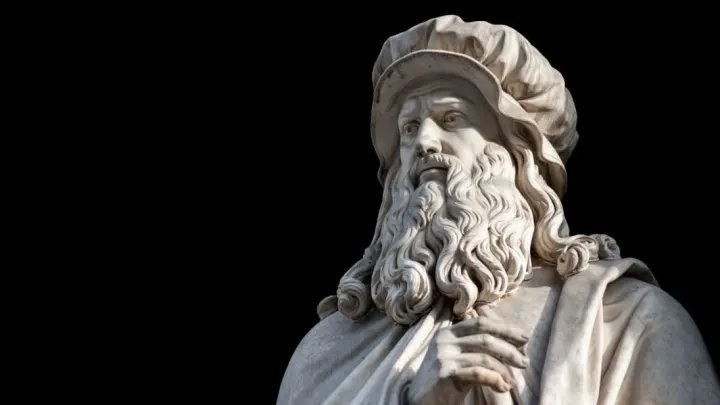
- Leonardo da Vinci (1452 to 1519) was the ultimate Renaissance man, a genius who spent his days and hours studying art and other studies such as medicine, science, and inventions; there was nothing he could not study or learn. He relentlessly studied autonomy, the nature of light, and the structure of plant and animal life, so he had little time to paint; the art he created is considered a Renaissance masterpiece.

- Michelangelo (1475 to 1564) was a creative genius who was not afraid to take on vast projects. Michelangelo drew a lot of inspiration from the perfected human form and continues to be one of the most influential artists who ever lived.
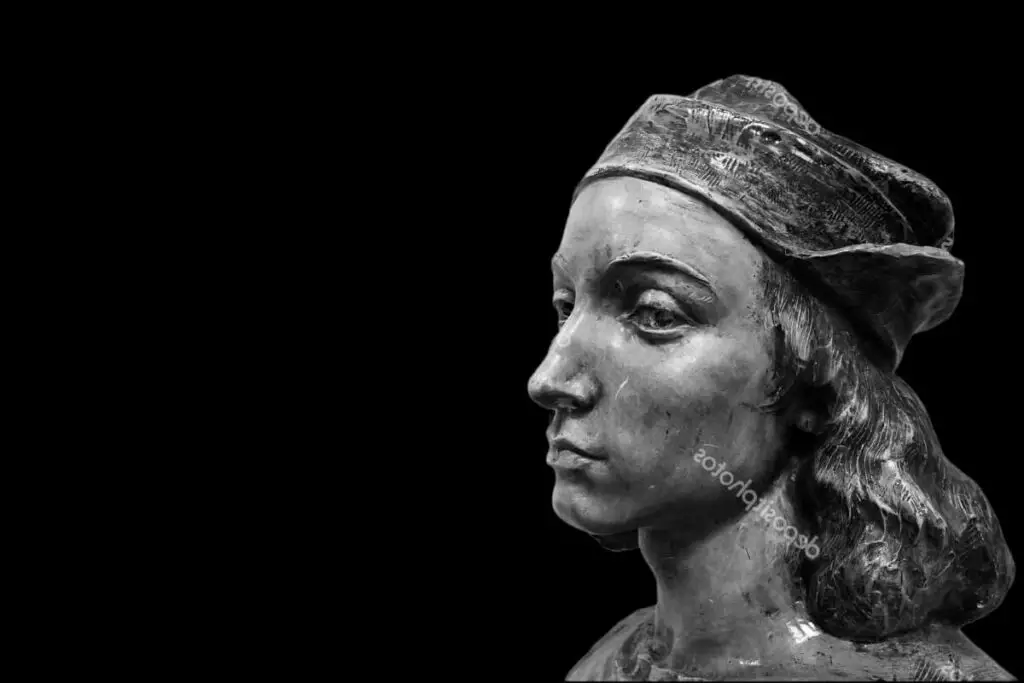
- Raphael (1483 to 1520) was an artistic genius who created work that perfectly expressed the Classical spirit of harmony, beauty, and serenity. He was a very influential Renaissance artist who also painted many masterpieces.
The Italian High Renaissance emerged around Florence and other heavily populated areas centered around the Roman Catholic Church’s many prominent cathedrals. The High Renaissance built upon the same characteristics as the Early Renaissance, but there were specific aspects of the High Renaissance.
Here are a few aspects of the High Renaissance:
- Three Major Artists Influenced The High Renaissance – Leonardo da Vinci, Michelangelo, and Raphael were central figures of the High Renaissance.
- Religious Art – During the High Renaissance, artists took a great interest in religious themes and ideas that were part of Christianity.
- Many Religious Commissions – In the High Renaissance, many artists received art from the Catholic church. The churches in Italy also controlled a lot of wealth, so this directly correlated with the artists doing art commissions at the request of church leaders.
At the end of the High Renaissance era, the Renaissance ended. Some historians say that the Renaissance ended at the death of Raphael. Most believe it happened sometime later with the sacking of Rome by Charles V; the sacking of Rome came about in 1527 and brought an end to the golden age of the once-thriving nation of Italy.
Charles V became the Holy Roman Emperor and Archduke of Austria, King of Spain and Lord of the Netherland, and Duke of Burgundy; for a time, he controlled most of Europe, including Italy.

Listen To Our Podcast About Early Renaissance Vs. High Renaissance Art Explained? by clicking here.
The Renaissance “Rebirth” Term Explained
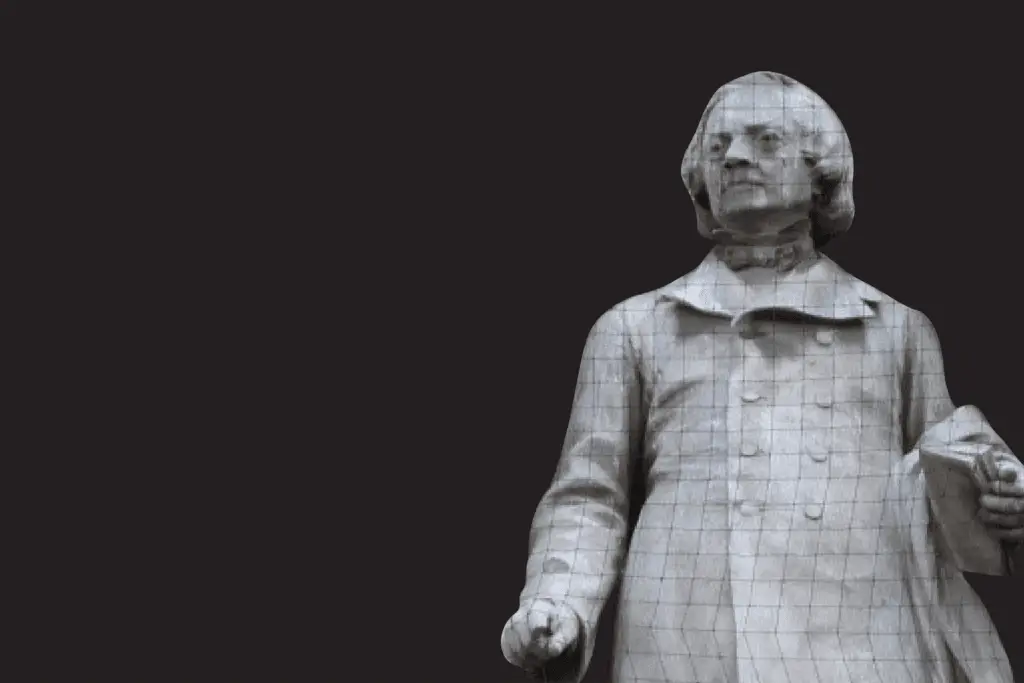
The term Renaissance was not used until a French historian named Jules Michelet used the term “Renaissance” to refer to the paintings, architecture, and sculptures created in Italy from 1400 to 1530.
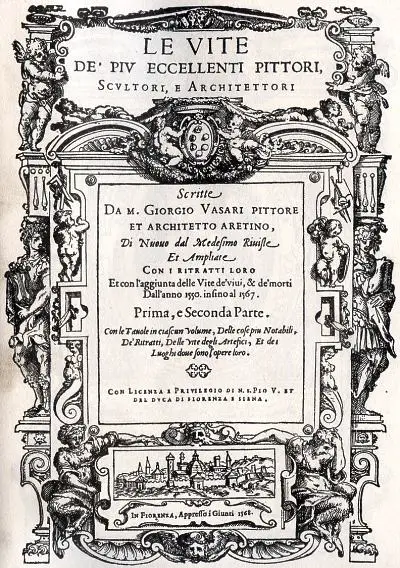
The term Renaissance was based upon the Renaissance author Giorgio Vasari using the word “rebirth” in his book The Lives of the Most Excellent Painters, Sculptors, and Architects (also known as Lives of the Artists – 1568).
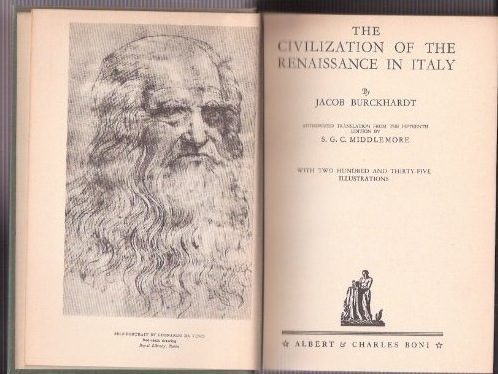
The term was used by Jacob Burckhardt when he published his book two years after Jules Michelet. “The Civilization of the Renaissance in Italy” in98yghuffghu about 1860. The word Renaissance started to become a convenient way to describe this period.
The Italian artists and elite never used the word Renaissance or Rinascita, but they were conscious that this was a unique period of cultural rebirth that was taking place.
12 Reasons Why I’m Enamored with the Renaissance Period of Art
The world of art has seen countless movements and epochs, but something about the Renaissance tugs at my heartstrings like no other. Whenever I delve into this era, I find myself lost in its allure and grandeur.
Here are twelve reasons why the Renaissance period of art has a special place in my heart:
- A Galaxy of Great Artists: The Renaissance introduced me to a constellation of art giants. Names like Leonardo da Vinci, Michelangelo, Raphael, and Titian – each one a maestro in his own right. It’s genuinely astounding how one period could produce so many legends.
- A Treasure Trove of Artworks: Every artwork from this era feels like a gem. From the enchanting “Mona Lisa” to the grandeur of the Sistine Chapel ceiling, the sheer volume of masterpieces from the Renaissance never ceases to amaze me.
- A Revolutionary Shift: The Renaissance, for me, wasn’t just another art movement. It revolutionized the world of art, introducing techniques and ideas that laid the foundation for modern art.
- Rebirth of Ideas: I’m fascinated by how the Renaissance bridged the gap between the ancient and the modern. It rejuvenated Greco-Roman ideals, blending them with the innovations of the time.
- Humanism at Its Core: What speaks to me most is the humanistic approach of Renaissance art. The emphasis on individual expression, emotion, and the human experience makes every piece relatable.
- Technological Advancements: The Renaissance heralded innovative techniques, like linear perspective, that changed how I perceive art. These techniques brought depth, realism, and vibrancy to artworks.
- Harmony and Proportion: The harmonious compositions and the emphasis on proportion make Renaissance artworks a visual treat for me. There’s a sense of balance that’s both pleasing and awe-inspiring.
- Exploration of Anatomy: I appreciate the detailed anatomical studies that artists undertook. This exploration added a level of realism to their works that resonates deeply with me.
- Integration of Sciences: As a lover of art and science, I adore how the Renaissance blurred the lines between these domains. Leonardo’s “Vitruvian Man” is a perfect testament to this integration.
- Inspiration from Mythology: The infusion of mythological themes gives Renaissance art a dreamy, otherworldly aura. As someone who enjoys tales of gods and heroes, I find this period offers a delightful blend of art and legend.
- Emphasis on Nature: I love the delicate and detailed representation of nature in Renaissance art. It serves as a reminder of the beauty that surrounds us and the inspiration it offers.
- Lasting Legacy: Even today, the Renaissance influences countless artists, scholars, and enthusiasts like me. Its enduring impact on art and culture serves as a testament to its timeless significance.
The Renaissance isn’t just a chapter in the annals of art history for me; it’s a journey, a revelation, and a perennial source of inspiration. Every brushstroke and chiseled figure from this era whispers tales of innovation, passion, and the indomitable human spirit.
Anita Louise Art is dedicated to art education, great artists, and inspiring others to find and create their art. We love art that uplifts and inspires. #ArtToMakeYouSmile! #ArtToMakeYouHappy!
If you are interested in seeing any of my art, you can find out more by clicking here. If you are interested in what inspires me and my paintings, you can discover more by clicking here.
We have a free newsletter and would love you to be part of our community; you can subscribe to the newsletter by clicking here. If you have any questions, I would be happy to talk to you. You can reach me, Anita, by clicking here.
Subscribe to our Anita Louise Art YouTube Channel, which is filled with great videos and information, by clicking here.
Join us for our podcast “5 Minutes With Art.” Spend just 5 minutes a week with us to discover and learn about great art and artists. You can find out more about our podcast by clicking here.
Frequently Asked Questions
What is the Early Renaissance?
The Early Renaissance is a period in art history that began in Italy in the 14th century and continued to the late 15th century. A focus on perspective, anatomical accuracy, and a revived interest in classical Greek and Roman art and architecture characterize it.
What is the High Renaissance?
The High Renaissance, which spanned roughly the early 16th century, is considered the peak of Renaissance art, marked by great technical sophistication and a harmonious balance in the composition. The period is associated with famous artists like Leonardo da Vinci, Michelangelo, and Raphael.
How does the art from the Early Renaissance differ from the High Renaissance?
Early Renaissance art was more focused on developing the techniques and conventions that would define Western art for centuries, such as linear perspective and a greater realism in human figures. A greater refinement of these techniques, increased complexity and grandeur, and a stronger influence from classical antiquity characterize High Renaissance art.
Who were some prominent artists of the Early Renaissance?
Some prominent artists of the Early Renaissance include Masaccio, Donatello, and Fra Angelico.
Who were some prominent artists of the High Renaissance?
Some of the most famous artists of the High Renaissance are Leonardo da Vinci, Michelangelo, and Raphael.
What are some key works of the Early Renaissance?
Key works of the Early Renaissance include Masaccio’s “The Holy Trinity,” Donatello’s “David,” and Botticelli’s “The Birth of Venus.”
What are some key works of the High Renaissance?
Key works of the High Renaissance include da Vinci’s “Mona Lisa,” Michelangelo’s Sistine Chapel ceiling, and Raphael’s “School of Athens.”
How did the themes of art change from the Early Renaissance to the High Renaissance?
While religious themes continued to be important throughout both periods, the High Renaissance saw an increasing interest in classical mythology and a greater integration of secular themes and humanist ideals.
Related Questions
What Was The Focus Of Renaissance Art?
The focus of Renaissance art was on the classics of Greek and Rome, humanist philosophy, and the study of the human figure. Realism was also an essential part of renaissance art. The great artists of the Renaissance also became great anatomists and studied human beings.
By clicking here, you can learn more by reading What Was The Focus Of Renaissance Art?.
What Is The Importance Of Art From The Renaissance Period?
Renaissance art is essential as it was a time of rebirth and discovery. Artists like Leonardo da Vinci, Michelangelo, and Raphael were at the forefront of that change, creation, and discovery. Renaissance art has influenced art and artists for many centuries and continues to influence artists today.
By clicking here, you can learn more by reading What Is The Importance Of Art From The Renaissance Period?.
Did Leonardo da Vinci Believe In God?
Leonardo did not tell us what his belief in God was, but there is evidence that is left that suggests that he held fast to many Christian ideals and beliefs. People such as the artist and author Giorgio Vasari, who knew him and wrote about him, spoke of his character and what a great man he was.
By clicking here, you can learn more by reading Did Leonardo da Vinci Believe In God?.

